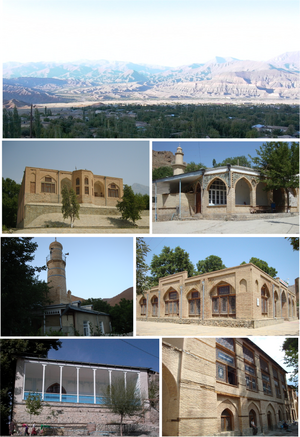
The Nakhchivan Autonomous Republic is a landlocked exclave of the Republic of Azerbaijan. The region covers 5,502.75 km2 (2,124.62 sq mi) with a population of 459,600. It is bordered by Armenia to the east and north, Iran to the southwest, and Turkey to the west. It is the sole autonomous republic of Azerbaijan, governed by its own elected legislature.

The Treaty of Turkmenchay was an agreement between Qajar Iran and the Russian Empire, which concluded the Russo-Persian War (1826–1828). It was second of the series of treaties signed between Qajar Iran and Imperial Russia that forced Persia to cede or recognize Russian influence over the territories that formerly were part of Iran.
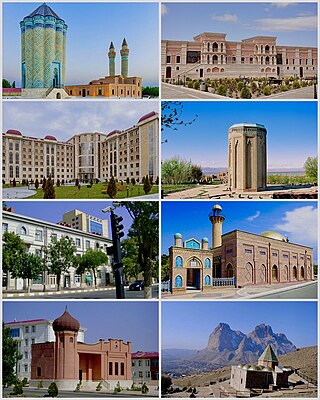
Nakhchivan is the capital and largest city of the eponymous Nakhchivan Autonomous Republic, a true exclave of Azerbaijan, located 450 km (280 mi) west of Baku. The municipality of Nakhchivan consists of the city of Nakhchivan, the settlement of Əliabad and the villages of Başbaşı, Bulqan, Haciniyyət, Qaraçuq, Qaraxanbəyli, Tumbul, Qarağalıq, and Daşduz. It is spread over the foothills of Zangezur Mountains, on the right bank of the Nakhchivan River at an altitude of 873 m (2,864 ft) above sea level.

Ordubad District is one of the 7 districts of the Nakhchivan Autonomous Republic of Azerbaijan. The district borders the district of Julfa, as well as the Syunik Province of Armenia, and the East Azerbaijan Province of Iran. Its capital and largest city is Ordubad. As at 2020, the district had a population of 50,200.
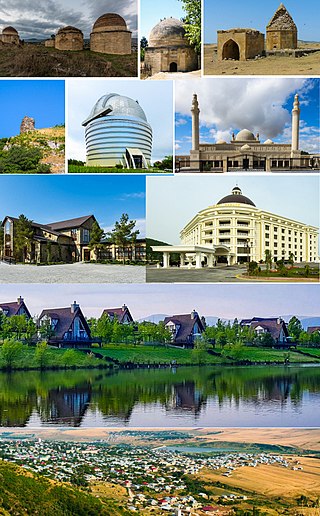
Shamakhi is a city in Azerbaijan and the administrative centre of the Shamakhi District. The city's estimated population as of 2010 was 31,704. It is famous for its traditional dancers, the Shamakhi Dancers, and also for perhaps giving its name to the Soumak rugs.

Merzifon is a town in Amasya Province in the central Black Sea region of Turkey. It is the seat of Merzifon District. Its population is 61,376 (2021). The mayor is Alp Kargı (CHP).
Julfa, formerly Jugha, is a city and the capital of the Julfa District of the Nakhchivan Autonomous Republic of Azerbaijan.
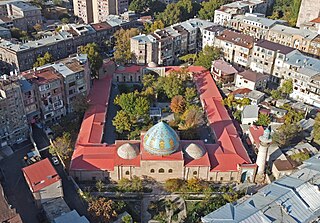
The Blue Mosque is an 18th-century Shia mosque in Yerevan, Armenia. It was commissioned by Hoseyn Ali Khan, the khan of the Iranian Erivan Khanate. It is one of the oldest extant structures in central Yerevan and the most significant structure from the city's Iranian period. It was the largest of the eight mosques of Yerevan in the 19th century and is the only active mosque in Armenia today.

The Erivan Governorate was a province (guberniya) of the Caucasus Viceroyalty of the Russian Empire, with its centеr in Erivan. Its area was 27,830 sq. kilometеrs, roughly corresponding to what is now most of central Armenia, the Iğdır Province of Turkey, and the Nakhchivan exclave of Azerbaijan. At the end of the 19th century, it bordered the Tiflis Governorate to the north, the Elizavetpol Governorate to the east, the Kars Oblast to the west, and Persia and the Ottoman Empire to the south. Mount Ararat and the fertile Ararat Valley were included in the center of the province.
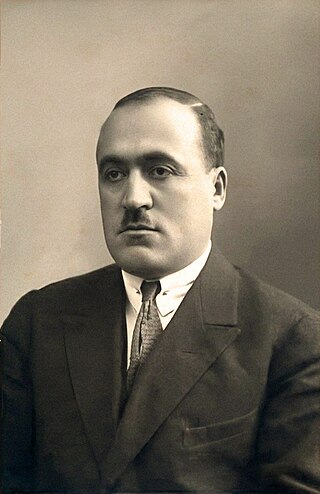
Mammad Said Ordubadi was Azerbaijani writer, poet, playwright and journalist.
Armenians in Azerbaijan are the Armenians who lived in great numbers in the modern state of Azerbaijan and its precursor, Soviet Azerbaijan. According to the statistics, about 500,000 Armenians lived in Soviet Azerbaijan prior to the outbreak of the First Nagorno-Karabakh War in 1988. Most of the Armenian-Azerbaijanis however had to flee the republic, like Azerbaijanis in Armenia, in the events leading up to the First Nagorno-Karabakh War, a result of the ongoing Armenian-Azerbaijani conflict. Atrocities directed against the Armenian population took place in Sumgait, Ganja and Baku. Today the vast majority of Armenians in Azerbaijan live in territory controlled by the break-away region Nagorno-Karabakh which declared its unilateral act of independence in 1991 under the name Nagorno-Karabakh Republic but has not been recognised by any country, including Armenia.
Azadkənd is a village and municipality in the Ordubad District of Nakhchivan, Azerbaijan. It is located in the left side of the Ordubad-Nakhchivan highway, 20 km in the south-west from the district center, on the right bank of the Gilanchay River. Its population is busy with gardening, vegetable-growing, farming, vine-growing, poultry farming and animal husbandry. There are secondary school, club, hospital and kindergarten in the village. It has a population of 1,054.

Aşağı Əylis or Agulis is a village and municipality in the Ordubad District of Nakhchivan, Azerbaijan. It is located in the near the Ordubad-Yuxarı Aylis highway, 3 km in the east from the district center, on the bank of the Aylis River. Its population is busy with gardening, farming, animal husbandry. There are secondary school, club and a medical center in the village. It has a population of 1007.
Vənənd is a village and municipality in the Ordubad District of Nakhchivan, Azerbaijan. It is located in the near of the Ordubad-Unus highway, 17 km in the north-west from the district center, on the bank of the Vanandchay river. People of the village is busy with gardening, grain growing, cotton-growing, animal husbandry. There are secondary school, music school, library, culture house, a medical center and kindergarten in the village. It has a population of 2,347. The municipality consists of the villages of Vənənd and Xanağa.

Yuxarı Əylis is a village and municipality in the Ordubad District of Nakhchivan, Azerbaijan. It is located in the left and right sides of the Ordubad-Aylis highway, 12 km in the north-east from the district center. Its population is busy with gardening, farming, animal husbandry. There are secondary school, club, library, communication branch and a medical center in the village. It has a population of 1,916.
Dırnıs is a village and municipality in the Ordubad District of Nakhchivan, Azerbaijan. It is located in the near of the Ordubad-Unus highway, 29 km in the north-east from the district center, on the bank of the Venend River. Its population is busy with gardening, vegetable-growing and farming. There is a secondary school, club, library, culture house, medical center and the mosque of the Middle Ages in the village. It has a population of 1,470. In the territory of the village, in the cemetery were medieval a stone ram statues on the graves.
Bist is a village and municipality in the Ordubad District of Nakhchivan, Azerbaijan. It is located in the near of the Ordubad-Nurgut highway, in the north-west from the district center. Its population is busy with gardening, beekeeping and animal husbandry. There are secondary school, club, library and a medical center in the village. It has a population of 483.
Darkənd is a village and municipality in the Ordubad District of Nakhchivan, Azerbaijan. It is located in the south of the Ordubad-Nakhchivan highway, 15 km in the south-west from the district center, on the right bank of the Gilanchay River. Its population is busy with gardening, vegetable-growing, animal husbandry. There are secondary school and a medical center in the village. It has a population of 500. The ruins of the historical and architectural monuments is in the territory of the village. The tomb, the mosque's minaret, etc. is attracting attention.

Armenians had a historic presence in Nakhchivan. According to an Armenian tradition, Nakhchivan was founded by Noah, of the Abrahamic religions. During the Soviet era, Nakhchivan saw a significant demographic shift. The Armenian population saw a great reduction in their numbers throughout the years repatriating to Armenia. Nakhchivan's Armenian population gradually decreased to around 0%. Still some Armenian political groupings of Armenia and the Armenian diaspora, claim that Nakhchivan should belong to Armenia. The Medieval Armenian cemetery of Jugha (Julfa) in Nakhchivan, regarded by Armenians as the biggest and most precious repository of medieval headstones marked with Christian crosses – khachkars, was completely demolished by 2006.

The Agulis massacre was a massacre of the Armenian population of Agulis by Azerbaijani state authorities and Azeri locals from Ordubad and refugees from Zangezur as part of the Muslim uprisings in Kars and Sharur–Nakhichevan against the First Republic of Armenia. The attack, lasting from December 24 to December 25, 1919, resulted in the destruction of the town of Agulis.
